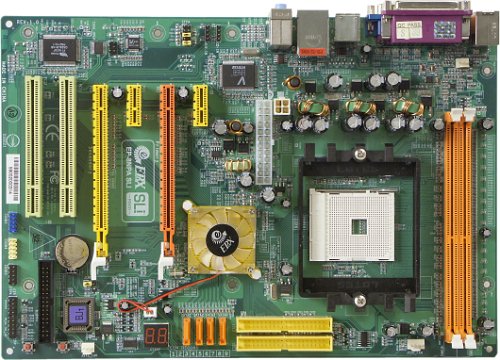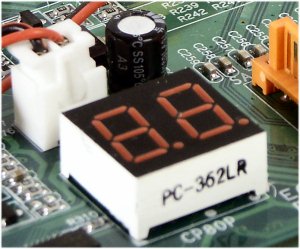 |
||
|
||
| ||
NVIDIA consistently expands the limits of its SLI, both upwards, by launching nForce4 SLI X16 chipset, and downwards (first of all by adding video cards to the SLI compatible list of models on 6600 and 6600LE GPUs). It goes without saying that there is no point in buying initially two low-end cards instead of one, on a par to their joined performance. No one is going to persuade you to do it. But if your budget is limited to only one inexpensive video card, reserving an option to reinforce the video system in future by adding another such card may be a good idea. But only under condition that you won't have to pay the sum, sufficient for a solo video card of the latest generation. This condition requires an inexpensive SLI motherboard, supporting budget processors, which are usually installed on such computers. EPoX published another advantage of the 8NPA SLI motherboard (Socket 754) in the ad, included into the bundle — maximum ratio between gaming performance and price for a limited budget gamer. The company offers to reach this ratio by assembling a computer on this motherboard with a couple of 6600GT/6800LE video cards. Indeed, you can get a bonus in games that load mostly video cards by reinforcing the graphics system at the cost of the platform. Especially as the top Socket 754 processor (Sempron 3400+) and still available Athlon 64 processors with a single-channel memory controller can certainly manage any modern game. But let's drop the immense issue of assembling a balanced configuration and proceed to the review of this EPoX motherboard.  The motherboard is based on the full-featured version of nForce4 SLI chipset (HyperTransport is limited to 800 MHz only to conform to Socket 754 processors), and so the choice of peripheral interfaces surpasses the budget level. At the same time, despite the narrow PCB, it does not look overcrowded with additional controllers, all the functions are provided by the chipset. Both PCI Express x16 slots always work in 8x mode irregardless of the number of installed video accelerators, the number of lines cannot be changed. You just have to activate SLI in drivers to enable this mode (if you unite low end cards, which do not support SLI Bridge, you'll need Detonator 77.77 or higher). Interestingly, a single card can be installed to the first as well as to the second slot. It will have no effect on the performance, though the documentation states otherwise. An only shortcoming of the motherboard is its two memory slots. But considering the lack of dual-channel mode, you don't have to buy two modules at once. So the majority of users will be satisfied, even if they plan to upgrade the memory capacity in future. On the whole, the PCB layout is good. We can find fault only with the power connectors, located in the center: it's a technically good solution (it reduces the distance between these power connectors and CPU voltage regulators, PCI Express lines, etc), but power cables impede air cooling of the processor and power unit components. Besides, the only jumper (clear CMOS) is covered by the cooling system of the second video card. Brief description of this jumper is provided on the PCB. The 3-phase switching voltage regulator of the processor incorporates two filed-effect transistors per channel, six 3300 uF and three 1500 uF capacitors. The memory voltage regulator is reinforced with L-elements. All capacitors are from respectable Rubycon. There are no empty seats on the motherboard. So far, it's the only model from EPoX with this combination of a chipset and a processor socket, so its PCB layout is unique. Motherboard dimensions — 305×225 mm (narrow ATX), seven-screw mount, the nearest edge is "poised in the air" on the level of storage drive connectors. System monitoring (Fintek F71872F LPC, according to BIOS Setup)
Developed SmartFan menu allows to set up advanced control of the CPU cooler activity. It offers three temperature thresholds, each with its own configurable rotational speed (percents of the maximum speed):
Onboard ports, sockets, and connectors
Back panel (left to right, blockwise) Click the image to open the rear view of this motherboard
Package Contents
The standard set of utilities includes: EPoX Thunder Probe (monitoring system parameters and SmartFan mode settings), MagicScreen (personal bootup screen design), and Magic Flash (BIOS update under Windows, capable of searching and downloading the latest version from the official web site). Integrated Controllers
The integrated audio quality was tested in 16bit, 44 kHz using the RightMark Audio Analyzer 5.5 test application and the Terratec DMX 6fire sound card:
General performance: Good (Details). Proprietary technologies and peculiarities
Settings
We used BIOS dated 14.09.05, the latest available BIOS version at the time of our tests. The mentioned BIOS parameters are available in this version, but the viability of non-standard settings hasn't been tested. There is a load menu function, which allows to choose a boot device to startup a system without modifying BIOS Setup, if you press Esc at startup. Interestingly, the system prompts at startup whether the order of boot devices in BIOS was modified and asks for a confirmation. Timings and memory frequency are conveniently highlighted on the bootup screen, Magic Health window is also located there (at the bottom of the screen), which displays temperatures, rpms, voltages — everything offered by system monitoring. Any memory modules were set to 333 MHz 2T mode by default, while the other timings were detected correctly (by SPD)! Fortunately, 8NPA SLI allowed to correct this mistake by switching to 1T and 400 MHz manually. Besides our elite Corsair modules, the motherboard detected standard timings and passed tests with ValueRAM from Kingston (2 x 512 MB DDR400 2.5-3-3-7). We should note that BIOS supports additional memory multipliers, introduced by AMD in the latest generation of 90-nm cores (San Diego, Venice, and Palermo). Thus, we can "legally" use our Sempron 3400+ with DDR500 memory modules, retaining other standard parameters. PerformanceTestbed configurations:
We have taken for comparison a motherboard on nForce4-4x chipset with Socket 754 from Elitegroup (ECS), as the "formally" closest model in our stock.
Obviously, we cannot say anything original about EPoX 8NPA SLI performance. Thanks to the option to specify minimum memory timings (and not least the 1T/2T Command Rate parameter), it takes the highest possible level for this configuration (processor/memory/video card). Bottom line: it's definitely an original and interesting model due to the combination of a budget CPU socket and SLI support. But how large will the "Value SLI" niche be (according to the official EPoX segmentation of its models, a system unit based on this motherboard must be below $389)? We should also note the rich functionality, support for the "proprietary" option of the nForce4 SLI chipset — firmware firewall for the gigabit network adapter, as well as SATA-II and developed RAID modes. In fact, this model lacks only FireWire to get to the high-end level. BIOS settings will please fans of manual configuration of frequencies and timings.
This model on the manufacturer's web site The motherboard is kindly provided by the manufacturer
Write a comment below. No registration needed!
|
Platform · Video · Multimedia · Mobile · Other || About us & Privacy policy · Twitter · Facebook Copyright © Byrds Research & Publishing, Ltd., 1997–2011. All rights reserved. | |||||||||||||||||||||||||||||||||||||||||||||||||||||||||||||||||||||||||||||||||||||||||||||||||||||||||||||||||||||